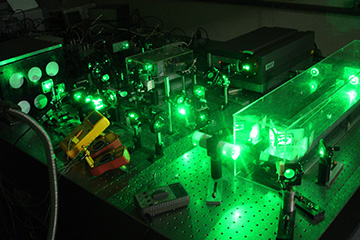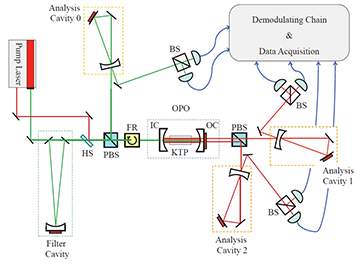
[Image: Marcelo Martinelli (IFUSP)]
A research team in Brazil has used an optical parametric oscillator (OPO) to demonstrate the simultaneous entanglement of six optical modes in one cavity, using a single continuous-wave (CW) laser source (Phys. Rev. Lett., doi: 10.1103/PhysRevLett.121.073601; Phys. Rev. A, doi: 10.1103/PhysRevA.98.023823). What’s more, the researchers showed that they could control the system’s level of entanglement via a single, easily accessed parameter—the power of the pump laser. The work could, in the view of the team, offer “a controllable and scalable source of entangled states” for wiring up quantum information networks.
Pump, signal, idler—times two
An OPO consists of a nonlinear optical crystal within an optical cavity. When pumped by an external laser of the right frequency, the crystal down-converts the pump beam into two beams of lower frequency, commonly called the “signal” and “idler” beams. The nonlinear crystal also acts as a gain medium, through the process of parametric amplification, giving rise to oscillation and to powerful signal and idler output beams once the pump power crosses a specific threshold.
Nearly a decade ago, members of the same research team as the one behind the current work demonstrated three-part entanglement between the pump, signal and idler beams in an OPO, using a self-homodyning measurement technique (Science, doi: 10.1126/science.1178683). A few years later, however, the researchers pointed out that the three beams are more properly viewed as carrier waves, with the quantum information actually packed within two weaker sideband modes for each of the three carrier fields (Phys. Rev. Lett., doi: 10.1103/PhysRevLett.111.200402). That raised the prospect of demonstrating not three-part, but six-part entanglement within an OPO—if a sufficiently sensitive measurement could be done.
Minding the sidebands
Setup for reconstructing the covariance matrix from the pump, signal and idler beams of an OPO. PBS, polarizing beam splitter; BS, 50:50 beam splitter; HS, harmonic separator; KTP, potassium titanyl phosphate nonlinear crystal; IC, input coupler; OC, output coupler (OPO cavity); FR, Faraday rotator. [Image: Reprinted figure with permission from F.A.S. Barbosa et al., Phys. Rev. Lett. 121, 073601 (2018), doi: 10.1103/PhysRevLett.121.073601; copyright 2018 by the American Physical Society] [Enlarge image]
To get there, the team—led by Marcelo Martinelli of the Instituto de Física da Universidade de São Paulo—began with a monochromatic (green) pump field from a doubled, filtered Nd:YAG laser, tied to the OPO using a partly reflective input coupler. Within the OPO, the light enters a nonlinear potassium titanyl phosphate crystal, where part of the pump light is downconverted into infrared signal and idler beams. Next, the team jacked up the pump power to 75 percent above the OPO’s oscillation threshold, and cooled the crystal down to 260 K to limit thermal noise.
The resulting amplified signal and idler beams, as well as reflected, non-down-converted pump light, were collected in three separate “analysis cavities” to allow for fine-tuning, and then traveled on to three pairs of photodetectors. The photocurrent output from the photodetectors allowed the in-phase and quadrature quantum-optical components of the field to be measured. Finally, the team plugged in those measured values to create a covariance matrix for the system, and used the eigenvalues of that matrix to determine the entanglement state of the six sidebands of the pump, signal and idler fields.
A bridge for “multicolor quantum networks”
The team found that the covariance matrix measurements agreed well with the values expected from numerical calculations for a six-part entangled system. What’s more, the experiments revealed that, up to a certain point, the degree of sideband entanglement could be improved by boosting the pump power. Above a certain power level, however, the beams become coupled with phonons in thermal reservoirs in the crystal, which introduces noise and degrades the level of entanglement. That problem, according to the team, should be surmountable by further cooling down the nonlinear crystal.
The entanglement of six optical modes from a single CW laser effectively doubles the three-part entanglement achieved in earlier OPO experiments. In principle, of course, the team’s experiments also show that no more than six optical modes can be entangled in an OPO system such as this—there are, after all, only three beams and six sidebands to work with. But the Brazilian group believes that putting together multiple OPO systems and lasers could enable them to entangle larger numbers of optical modes.
And, in the team’s view, the ability to do so—and to control the quantum states by tweaking the pump power—opens some interesting doors in the design of quantum information systems, and even the development of a future quantum internet. “Our platform allows for the generation of massive entanglement among many optical modes with well-defined but vastly different frequencies,” the authors conclude, “potentially bridging nodes of a multicolor quantum network.”

